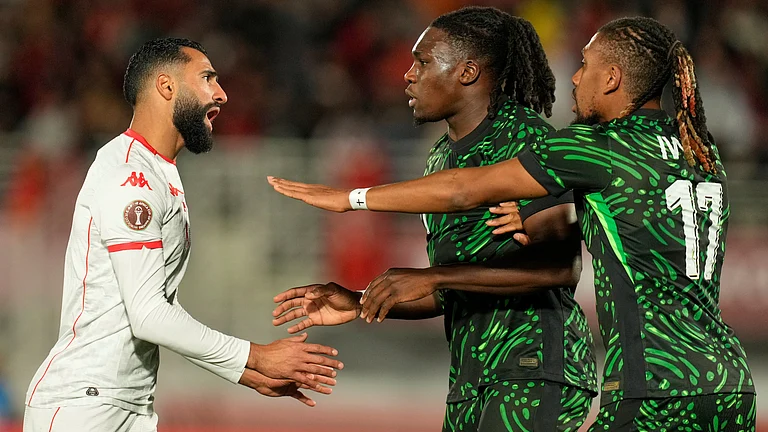- Option 1
Anil: Gets RIC, RCIL, Reliance Energy and Reliance Capital
The 29% family stake in RIL: Divided in the following ratio—30% Mukesh, 30% Anil, 30% mother Kokilaben, and 5% each to two sisters, Dipti and Nina; Kokilaben may become the trustee for the stakes given to her two daughters.
Anil's Future: Either he gets a commitment from RIL for supply of gas for his proposed power project or the gas division is spun out of RIL and given to him.Grey Areas: RIC is Mukesh's baby; he may not want to part with it. RIC needs huge funds infusion, so Anil may not be happy with it. Anil has criticised the high price (Rs 50 for a Re 1 share) paid by RIL to invest Rs 8,100 crore as preference shares in Reliance Infocomm. But he may now want it to be converted into equity at a still higher premium which is contrary to his past stance. Anil may find it difficult to invest Rs 10,000-15,000 crore that's required to exploit the Krishna-Godavari fields.
- Option 2
Anil: Gets Reliance Energy and Reliance Capital.
The 29% family stake in RIL: Divided in the following ratio—30% Mukesh, 30% Anil, 30% mother Kokilaben, and 5% each to two sisters, Dipti and Nina; Kokilaben may become the trustee for the stakes given to her two daughters.
Anil's Future: Either he gets a commitment from RIL for supply of gas for his proposed power project, or the gas division may be spun out of RIL and given to him. Mukesh's 55% stake in Reliance Infocomm is valued separately, and half of it goes to Anil as cash.
Grey Areas: It leaves Anil as the loser, with control over just 10% of the group's revenues.Anil may find it difficult to invest Rs 10,000-15,000 crore that's required to exploit the Krishna-Godavari fields. Valuation of Mukesh's stake in Reliance Infocomm will be tricky; different formulae will lead to varying prices, and the brothers may quibble to make the other accept what's more favourable to each of them.
- Option 3
Anil: Gets Reliance Energy and Reliance Capital
RIL: Run by both brothers with family stake divided equally between them
Grey Areas: Unworkable, because it'll be difficult for the duo to work together
Early last week, there was a new buzz in the Mumbai CEO circuit. A corporate honcho who claims to be close to the two feuding Ambani brothers revealed, "I met Anil a few days ago. He looked quite relaxed and wasn’t tense. I got the feeling that some sort of a patch-up is in the offing." At a glitzy party hosted by the Tatas mid-week, another well-known CEO admitted the same, saying that a smooth division between Mukesh and Anil would not take long. Towards the end of the week, the media was predicting the end of what turned out be India’s most vicious corporate battle.
Among Reliance insiders too, the tone changed last week. Rather than take extreme positions, they were reconciliatory. Said one of them, "Anil is resigned to the fact that he can’t get what he wants and Mukesh knows he’ll have to part with a few jewels to secure a peaceful division." What was surprising was the attitude of Anand Jain, Mukesh’s most trusted advisor and the man in charge of countering Anil’s offensive. "I’m a finance guy. Now that the financial issues are no longer in the picture, I don’t want to talk. Speak to our spokesperson and don’t call me," he said angrily. Was this an indication that the time to hiss is over and now it’s kiss, discuss and make up?
There was another reason to believe that something was up.Two months ago, Jain told Outlook, the only way to gauge that a deal was being hatched was to watch out for that lull, that period when the two camps will stop talking to the media and instead start talking to each other.Indeed, in the last few weeks, the set of advisors on both sides seemed to have taken a break. Some of them stopped taking calls from journalists. Others were busy re-planning their long-pending vacations—remember, all of them had to cancel their New Year’s holidays because of the brotherly fallout.
For four months, Anil had carried out a scathing attack on elder brother Mukesh. The sibling rivalry over control of the Rs 1,00,000-crore Reliance group had reached such a pitch that many predicted the demise of the sprawling empire. After dozens of skeletons came tumbling out of the Ambani cupboard, a close family watcher had remarked: "In any other country, or if it was any other business family in India, the two brothers would have been arrested by now. It’s their political clout that’s helped them."
Better sense has prevailed. Now the Ambanis have embarked on a path that’ll enable them to take separate routes at the division fork. Unfortunately, the triangular intersection is still far ahead. And the road is laden with land mines that can explode in their faces anytime. But first, let’s look at the options that are being discussed—Mukesh and Anil are still not talking to each other and their mother Kokilaben seems to be the sole trusted mediator.

Last month, the ICICI Bank supremo and a family friend, K.V. Kamath, submitted his report to Kokilaben. Apart from valuing the group’s assets, based on facts tendered by both camps, Kamath gave some hints about the manner in which they could be divided between the two brothers (see chart). He even studied recent family divisions in the US and a few East Asian nations like Malaysia. Helping him were several experts, including well-known investment banker Nimesh Kampani of JM Morgan Stanley. Let’s not forget that the ICICI Bank chief had the blessings of the finance minister, P. Chidambaram, who’s publicly admitted he knows the brothers and meets them regularly.
What Kamath had to essentially do was grapple with three critical issues. One, how to divide the family stake held through a matrix of investment firms in the flagship firm, RIL, between the five family members—mother, two brothers, and two sisters, Dipti Salgaoncar and Nina Kothari. Two, he had to struggle with clear demarcations in both control and management of the group’s businesses.Finally, he needed to assuage Anil’s insecurities about the latter’s future as an entrepreneur; Kamath had to devise a way to ensure that the group’s cashcow RIL continues to back some of Anil’s future projects.
All this had to be done in a "fair and equitable" manner. Therein lies the first series of mines.
Everything may be fair in war, but there’s nothing fair when it comes to ceasefire. There’re always winners and losers, as is evident from splits in business families across the globe. James Lea, professor, University of North Carolina, and an expert in family-run businesses, puts it succinctly: "I’ve found three simple words that cause a lot of the difficulties encountered by families in business. The first word is ‘mine’.... The second one is ‘when’.... The third word that can bring grief to family businesses is ‘fair’.... ‘I want to be fair to all the children’ is often the opening line in a family business tragedy."
Kokilaben, according to the Ambani insiders, has said that last sentence. Anil has repeated the words ‘fair’ and ‘equitable’ numerous times, often a dozen times in a single conversation. Mukesh’s advisors too have insisted on the word ‘fair’ while explaining the logistics of any possible deal. The trouble is that the same word connotes different things to the three members.
The mother feels that any division should be morally fair.That implies Mukesh can’t usurp the entire group and Anil shouldn’t be shortchanged. Ideally, Anil sees it as a 50:50 split in operational businesses and family wealth.Mukesh thinks he should get what he’s built single-handedly—which means over 90 per cent of the operational assets. Add to it the fact that any option should be seemingly fair to the 35 lakh shareholders of group companies; especially since Anil has made it the key principle while battling his brother.Now, we can look at the grey areas in the three black-and-white options that are apparently on Kokilaben’s—as also the brothers’—table.
Of the two big companies, if RIL goes to Mukesh, and Reliance Infocomm Ltd (RIC) to Anil, there’re problems. Mukesh—and his key men—have built the telecom venture with no help from family. Yes, most of the cash to finance it came from RIL, but that’s the case with all other group firms. So, the elder brother may not agree to part with his business baby. Of course, Anil won’t be too enthused by the prospect. Despite the fact that RIC has signed a loan agreement with foreign lenders to raise $750 million, its future is still tied to financial help from RIL. That umbilical cord can’t be cut too easily and Anil will feel uncomfortable if Mukesh has the scissors.
Another issue that’s likely to create bad blood is the premium that RIL paid for its investments in RIC and the latter’s holding company, Reliance Communications Infrastructure Ltd (RCIL). Over the last four months, Anil has screamed from the rooftops of Maker Chambers IV that the deal has been unfair to RIL; whereas RIL bought the stakes at a premium, Mukesh and his advisors/friends paid a face value of Re 1 per share. So if he gets the telecom firm, will he redeem the unfair transactions? Will he armtwist RIL to convert the Rs 8,100 crore preference shares in RIC into equity at a price lower than the existing premium of Rs 49 per share? But if he does that, he’ll have to deal with a bloated equity base of RIC that may be the death knell for the company. If he decides that the interests of RIL’s shareholders lie in RIC returning the money back to RIL, he’ll find it impossible to raise the money. He’ll be caught in a classic lose-lose Catch 22 situation.
Most importantly, what will be the valuation of the majority holding held by Mukesh and his advisors/friends in RCIL and the minority stake in RIC? It can’t be at face value now that the two firms are no longer at a start-up stage.Mukesh won’t agree to that.Anil will definitely not consent to valuations given by leading foreign investment bankers—up to Rs 250 a share for the telecom venture. (Ironically, the Anil camp had alleged that Mukesh and his friends got shares in RIC and RCIL for Re 1 per share, while independent agencies had pegged the price at a high Rs 250).
Anil will also have to contend with his future in the power business. He’s announced the Rs 10,000-crore project in Uttar Pradesh, but its viability depends on gas supply from RIL’s Krishna-Godavari fields. Will he be satisfied with a commitment from Mukesh, now that the two have fought bitterly in public? Or will Mukesh agree to give away the fields to his younger brother? Will RIL’s shareholders (especially foreign and domestic institutions) agree to the latter? Will the RIL board, which has categorically stated that the flagship can’t be split in any way, acquiesce?
However, the overriding advantage of option 1 is that it forces the two brothers onto totally different strategic paths. Mukesh becomes the manufacturing magnate and Anil the services superstar.
In that respect, the second option looks a bit weak. Mukesh gets RIL, RCIL, RIC and IPCL, which together constitute over 90 per cent of the revenues—and possibly assets. It may give the impression that Anil has emerged as a loser. This is especially so since the younger brother was claiming 50 per cent of the operational businesses.Obviously it’ll look unfair although the mother might not think so. For, in lieu of giving up RIC and RCIL, Anil will get a lot of cash.It’s time to disclose the second series of mines.
A part of this formula is that the 55 per cent stake held by Mukesh (directly or indirectly) in RCIL and RIC be valued, and half of it given to the younger brother in cash. The booty will allow Anil to pursue his mega dreams in other sectors. Yet again, the valuation will prove to be a tricky one. As the two companies are unlisted, there’s no market price. Experts have valued the telecom business—but there’s no consensus and the difference between their figures can imply a gain or a loss of a few thousands of crore of rupees for either of the two brothers. The so-called scientific methods like discounted cash-flows depend on various assumptions. So, a tussle on that front is bound to take place in the near future.
The major discord, however, will be in terms of egos. The two Ambanis have gone way too far in this fight. They don’t speak to each other. They badmouth the advisors around the other brother. The two camps have hurled personal allegations against each other. And what’s little-known is the ammunition that Anil has collected to target IPCL and RIL. Says an insider, "Till now, Anil has trained his guns on RIC and RCIL. If he does that on RIL and IPCL, there are bigger and more scary skeletons there. What you’ve seen is only the tip of Reliance’s controversial iceberg."
So, just forget about the third option—that the duo work together in RIL. It just seems an impossibility right now. And the hurt egos will also create hassles for Mukesh and Anil to agree to any other formula. Says a family source: "They’ll need to depend on some detached, objective family members to work out the details. Dipti’s husband Dattaraj Salgaoncar is one such person because he’s neither involved in the group’s businesses, nor is he interested in them. Nina’s husband Shyam Kothari handles a part of the group’s broadband business in the south, so he may be unacceptable. There’re other indirect family members who can also be roped in."
The House of Ambanis was built in haste—in less than three decades. Its corporate enemies were destroyed at a frenetic pace. The Ambani vs Ambani script was written in a hurry—the screenplay changing every day. But the split story will still be a long-winded one.


























